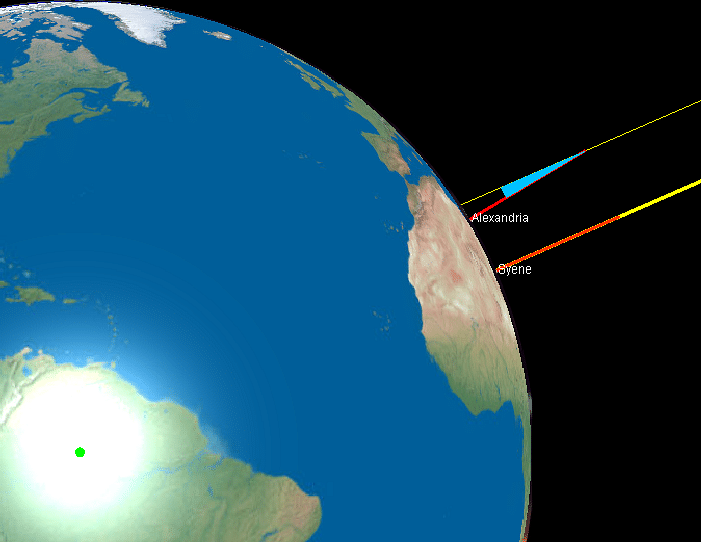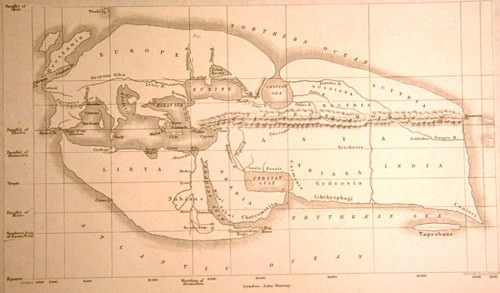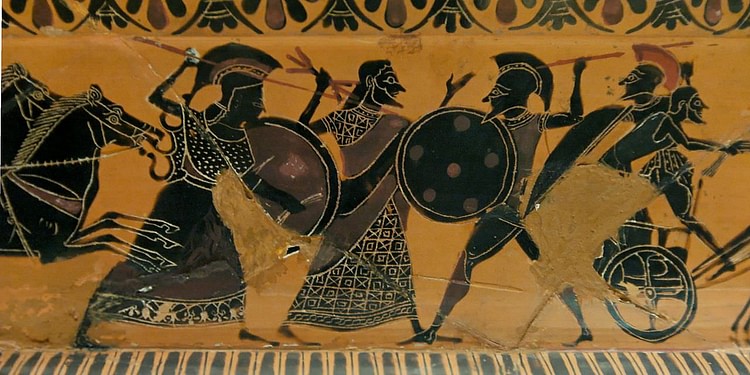Eratosthenes › Shield of Heracles » Ancient origins
Articles and Definitions › Contents
- Eratosthenes › Who Was
- Shield of Heracles › Antique Origins
Ancient civilizations › Historical and archaeological sites
Eratosthenes › Who Was
Definition and Origins

Eratosthenes (276-195 BCE) was an ancient Greek Alexandrian scholar, native of Cyrene, who attained distinction in many fields including philosophy, mathematics, astronomy and history. However, it was in geography where he proved to be more skillful for he was one of the greatest of all ancient geographers. Eratosthenes was also known as Beta : his erudition in many disciplines was remarkable but he often ranked second in all of them. It seems this nickname was chosen by those who disliked him, since Eratosthenes eventually proved that he was one step ahead of his contemporaries in several important areas of learning.
He was friends with Archimedes and the two exchanged ideas, enlarging each others knowledge. In fact, one of the surviving works of Archimedes, The Method, explained to Eratosthenes how mechanical experiments can help the understanding of geometry and this work also helped to encourage experimental methods in Eratosthenes. We can also see here the difference in approach between ancient and modern science. Ancient science used experimentation to help theoretical understanding while modern science uses theory to pursue practical results.
HISTORICAL CONTEXT
Around Eratosthenes' time the Greek cities of Egypt and the East were flourishing both materially and culturally and most of them were at their peak. Greek was firmly established as a common tongue as was cultural unity along most of the Mediterranean, especially in the eastern-Mediterranean. Every educated person was familiar with Greek and it was widely used as the medium in diplomacy, literature and science, therefore, a book written in Greek could not only be understood by native Greek speakers but also by virtually every educated non-Greek in Egypt and even the Near East.
BY THE AGE OF 40, ERATOSTHENES' VARIED KNOWLEDGE WAS SO HIGHLY REGARDED THAT PTOLEMY III OFFERED HIM THE ROLE OF DIRECTOR OF THE ALEXANDRIAN LIBRARY.
As a result of a very large Greek speaking audience, thousands of writers wrote hundreds of thousands of books and their number skyrocketed. Therefore, libraries, having existed in the past in Egypt and Mesopotamia mainly as a luxury, soon became a necessity. Ptolemy I, about 290 BCE, established the Museum and, as part of the Museum, the famous Library of Alexandria which ended up overshadowing the Museum in importance and interest, turning into a major centre of scholarship and research.
Books were considered so important that Ptolemy III ordered that every book brought to Alexandria should be deposited in the Library, the owner of the book should receive a copy of it while the Library kept the original. Government officials inspected every ship that arrived to Alexandria looking for books. He also borrowed from Athens many important manuscripts and gave the Athenians a large security deposit for their return. He finally sent back copies to Athens, the Library retained the originals and he told the Athenians they could keep the money as a fine. This ambition for old books became so intense that the art of dyeing and spoiling new manuscripts to sell them as antiquities to collectors of first editions turned out to be a risky but very profitable activity.
ERATOSTHENES' WORKS
His numerous works included various topics. Chronographia sought to accurately determine the dates of the major events in Mediterranean history. In this work he calculated the date of the siege of Troy at 1184 BCE, on the basis of traditional chronologies by the geographer-historian Hecateus. In Geographica he put together many reports from different travellers and explorers in order to describe the physical features of each region and he also explained them through the action of natural phenomena such as water, fire, earthquakes and volcanic eruptions. This work included the accounts of some the most prominent explorers in ancient Greece, including Pytheas of Massalia, who sailed around Scotland to Norway, and possibly to the Arctic Circle about 320 BCE. But it was his essay named On the Measurement of the Earth which challenged his Betanickname and clearly proved Eratosthenes was number one at combining theory with experimentation in order to produce the most accurate results possible at that time.
MEASURING THE EARTH
By the age of forty, Eratosthenes' varied knowledge was so highly regarded that Ptolemy III offered him the role of director of the Alexandrian Library, one of the most important positions which included the obligation of tutoring the crown prince. It was probably here where he read that in Syene (modern Aswan, Egypt), a city located due south of Alexandria, during the summer solstice (June 21st) something curious took place: the shadows of all objects would grow shorter as noon approached and finally, during noon, temple columns would cast no shadow and the sun would shine directly overhead. Deep wells, which at any other time of the year would remain in shadow, would have the sun shining directly down into them. He noticed that in Alexandria, during that same moment, objects would clearly cast a shadow. This account was surely read by many others, but nobody seemed to think it had any particular importance. Eratosthenes, as impossible as it may sound, saw in this report an opportunity to calculate the circumference of the Earth. It occurred to him he could do so by measuring the length of the shadow of the sun in Alexandria at the time when there was no shadow in Syene. On June 21st at noon, he measured the shadow of an obelisk in Alexandria and by simple geometry he calculated that the sun was 7° 14' from overhead.
It is because the surface of the Earth is curved that at the same time there would be no shadow in Syene and a clear shadow in Alexandria. Moreover, the greater the curvature, the bigger the difference in the length of the shadows. The sun is so far away from us that its rays are parallel when they reach the Earth: objects at different angles to the sun's rays would cast shadows of different lengths. Eratosthenes, based on the observed differences in the shadows' lengths, came to the conclusion that the distance between Alexandria and Syene had to be 7° 14' along the surface of the Earth. In other words, if we imagined one obelisk in Alexandria and another obelisk in Syene extending all the way down to the centre of the Earth, they would there intersect at an angle of 7° 14'. Since a full circle has 360°, 7° 14' is roughly one-fiftieth of the total circumference. Thus, the total circumference of the Earth was fifty times the distance from Alexandria to Syene.
The next step then was to find out the distance between Alexandria and Syene. There are different versions on how Eratosthenes attained this goal. Some say that travellers' reports indicated that camels needed 50 days to cover the trip from Alexandria to Syene and that a camel travelled 100 stadia a day. Others say that Eratosthenes hired a man to go from Alexandria to Syene counting the steps needed to complete the trip. What we know for sure is that he estimated the distance to be 5,000 stadia. We do not know exactly about the conversion of stadia into modern measures, but the general concensus is that 5,000 stadia would be around 800 kilometres. Eratosthenes therefore calculated the total circumference of the Earth to be 40,000 kilometres (250,000 stadia ).
Eratosthenes' calculation is about 15% too high, but the accuracy of his figure for the circumference of the Earth would not be equalled until modern times. His method was valid from a theoretical perspective, his measurements of angles were highly accurate but it was his measurement of distance that lacked precision. If he had had an accurate figure for the distance between Alexandria and Syene, his conclusion would have been almost the same as our modern estimations.

Eratosthenes' Map of the World
MAPPING THE EARTH
Eratosthenes also came up with a technique for charting the Earth's surface. He separated the world known to him into a Northern and Southern division using an east–west line parallel to the equator running through the island of Rhodes and bisecting the Mediterranean. He added a second north–south line at right angles running through Alexandria. Eratosthenes drew additional east–west and north–south lines to his map, but instead of adding these lines in regular intervals, he drew them through famous places: Meroë (the capital of the ancient Ethiopian kings), the Pillars of Hercules, Sicily, the Euphrates River, the mouth of the Indus River and the tip of the Indian peninsula.
The result was an irregular network that served human convenience. For the purpose of giving directions, a regular network would have been more useful, surely Eratosthenes was aware of this. But unfortunately in his day places were located by travellers' reports and oral tradition and this was not good enough to determine sufficient accurate points of reference to draw a regular network. It was Hipparchus of Nicea who later on took the next step and developed a neat regular grid that would provide the means to locate any place by following a simple set of coordinates. Nevertheless, Eratosthenes had certainly proved in his work that theory, observation and experimentation were a powerful and successful combination in the pursuit of knowledge.
Shield of Heracles › Antique Origins
Definition and Origins

The Shield of Heracles (also known as The Shield of Herakles, Aspis Herakleous ) is a poem of 480 hexameter lines written by an unknown Greek poet in the style of Hesiod (lived 8th century BCE). It deals with the Greek hero Herakles (also known as Hercules ) and his nephew Iolaus and their battle with Cycnus, son of the war -god Ares. It is unclear when the action of the poem takes place in the story of Heracles' life in myth and legend, but in the story Heracles and Iolaus are on their way to the city of Trachis (where Heracles and his second wife Deinara lived toward the end of their lives, but no mention is made of her or of any other events in the hero's life besides his birth) when they meet Cycnus and Ares.
The poem was thought to be an original work by Hesiod but was already suspect as the work of another by around the 3rd century BCE. Some modern-day sources continue to attribute the work to Hesiod even though by now it has long been established as the work of another writing in Hesiod's style. The poem borrows heavily from Homer 's Iliad, chapter 18, in which he describes the shield of Achilles. The author of The Shield of Heracles took some lines directly from Iliad and only modified others, but the majority of the poem is an original work. It was very popular in Greece, particularly Athens, in the 6th and 5th centuries BCE, and the story inspired representations in art on vases and drinking vessels.
HERACLES REMEMBERS THE WORDS OF ATHENA AND IGNORES THE PRIZE OF CYCNUS' SHINING ARMOR, KEEPING HIS EYES ON ARES AND BRACING FOR HIS ATTACK.
THE STORY
Cyncus was a cruel despot of Thessaly who invited guests to dinner and then murder them. He also would rob those pilgrims who were enroute to the sanctuary of the god Apollo to make sacrifices and leave gifts and offerings. One day, as Heracles and Iolaus were traveling in their chariot through the country, they met Cycnus and Ares in their own chariot coming from the other direction. They both stopped near the sanctuary of Apollo, where Cycnus challenged Heracles to single combat. Apollo, abiding close by in his sanctuary, stirred Heracles' blood to accept the challenge (even though, considering Heracles' temper and general character in the myths, he would have needed no encouragement). Heracles fights Cycnus and kills him with a spear through the throat. Ares then attempts to kill Heracles in revenge but is thwarted by the goddess Athena. Heracles wounds Ares in the thigh in this altercation and beats him. At this point, Ares' other sons, Panic and Dread, appear and take the wounded god back to Mount Olympus to be cared for. Cyncus is buried by King Ceyx of Thessal, and a great monument is set up to honor him, but Apollo causes the river Anaurus to flood and wash the grave away, so that Cycnus' memory would be blotted out because of his many evil deeds.
THE POEM
The poem begins with a description of Heracles' beautiful mother Alcmene and how she was impregnated by both the god Zeus and her husband Amphitryon on the same night, giving birth to twin sons: Heracles (son of Zeus) and Iphicles (son of Amphitryon). Amphitryon killed Alcmene's father, Electryon, over some cattle and then had to make amends before he could sleep with her. He is off at war defeating the kingdom's enemies when Zeus, in the form of Amphitryon, comes to Alcmene; the real Amphitryon returns later to Alcmene's bed after battle. This establishes Heracles as the son of the king of the gods and Iphicles as completely mortal. Iphicles never appears in the poem, but Iolaus, his son, is Heracles' charioteer (lines 1-56).

Gilded Bronze Hercules
After setting up the heroes of the tale, the poem presents the challenge to battle between Cycnus and Heracles near Apollo's sanctuary (lines 57-77). Heracles and Iolaus then have a conversation about their lives, the family's history, and the combat which Heracles is confident of winning (lines 78-121). The piece then describes Herakles putting on his armor and preparing for battle (lines 122-138) and goes into a detailed description of the shield which makes up most of the poem (lines 139-317).The shield is a masterwork of Hephaestus, god of the forge, who was directed in the making of it by Zeus himself. It is made of shining gold, adorned with ivory and electrum, and intricately detailed with many figures. The shield has never been broken or crushed - indeed, it cannot be - and features a personification of Fear and another of Strife prominently amidst the other figures of such things as writhing snakes, warriors, and gods such as Zeus and Ares.
Once the description of the shield is completed, the poem follows the heroes as they approach the place of battle (lines 318-326), at which point Athena appears and warns them, when they have killed Cycnus, not to become distracted by stripping the corpse of his armor or taking his horses but to pay attention to Ares who will attack them. She tells Heracles to watch for an opening beneath Ares' shield and to thrust at that spot with his spear to wound the god (lines 327-337). There then follows a description of the combat between Heracles and Cycnus with Iolaus and Ares watching from their respective chariots. The two warriors fight until Heracles drives his spear into Cycnus' throat and kills him (lines 338-423).
Heracles remembers the words of Athena and ignores the prize of Cycnus' shining armor, keeping his eyes on Ares and bracing for his attack. Ares springs upon Heracles, whose great shield withstands the onslaught of the god of war, and the two fight. Ares hurls his war spear, but Athena, watching over the combat, blunts the force of the weapon and causes it to turn aside. She tells Ares that it is not fated that he should kill Heracles and that he should stop fighting now, but Ares is too enraged over the death of his son. He draws his sword and again attacks Heracles who, seeing the moment Athena foretold, stabs Ares in the thigh underneath his shield and drives him to the ground and defeats him. Ares' other sons Panic and Dread then appear in a chariot and rescue their father, carrying him off to Mount Olympus (lines 424-466). The poem concludes (lines 467-480) with Heracles and Iolaus stripping Cycnus of his armor and continuing on their journey to the city of Trachis and descriptions of Cycnus' burial and Apollo bringing the flood to blot out all memory of Cycnus and his cruel works.
LICENSE:
Article based on information obtained from these sources:with permission from the Website Ancient History Encyclopedia
Content is available under License Creative Commons: Attribution-NonCommercial-ShareAlike 3.0 Unported. CC-BY-NC-SA License